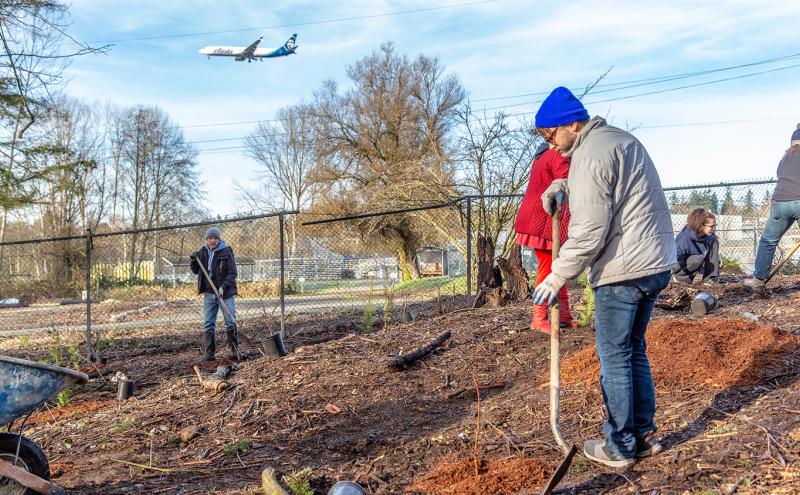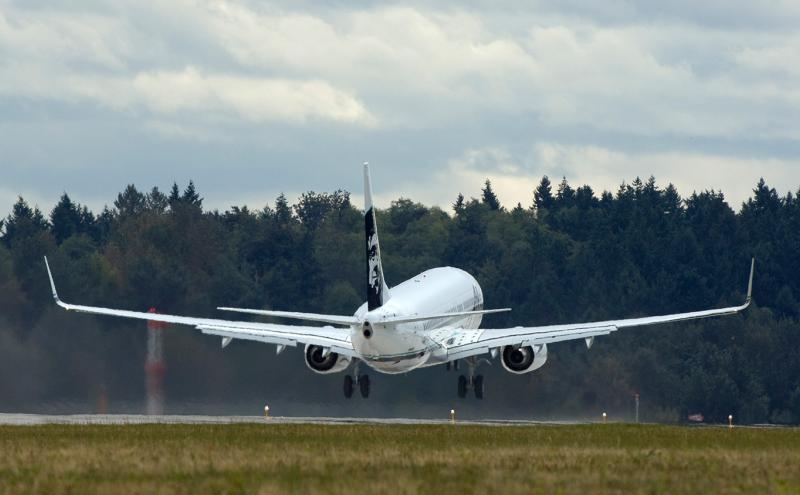
Trees and green spaces improve quality of life, providing shade, filtering pollution, removing carbon from the atmosphere, and easing the negative effects of urban heat and noise. But very tall trees planted near airport operations can pose a safety risk to aircraft.
In the last six years, Seattle-Tacoma International Airport (SEA) established a program that removes tall trees that pose the greatest safety risk and substantially expands the number of native trees planted in safe areas near the airport. For every tree that is removed, four trees are planted. The Port of Seattle launched the Flight Corridor Safety Program for SEA Airport in 2014. Using radar, the airport evaluates trees near the airport for removal based on whether they pose a hazard to flight safety. When an obstacle to safe flight is identified, the Port works with property owners to remove trees to improve safety during takeoffs and landings. And native trees are planted in their place in areas with no flight safety concerns.
The program helps the Port of Seattle meet Federal Aviation Administration (FAA) regulations and Washington state law, ensures safe flight operations, and ensures that the overall program advances the Port’s broader goals for sustainability, land stewardship, and community quality of life.
12,148 trees planted, 978 trees removed
Through the first two phases, approximately 12,148 trees have been or will be planted by the Port, Washington Department of Transportation (WSDOT), and other public entities to compensate for the removal of 978 trees on properties near the airport. The Port monitors its plantings for five years to ensure sites successfully re-establish trees and limit the spread of invasive species. Monitoring shows only 20 percent of planted saplings did not survive in their location. That low number means the Port will more than meet replanting ratio goals.
Great ideas grow
Phase I: 2014-2019
The first phase removed and replanted trees on Port property and restored native forests on airport property.
Phase 2: 2022
The second phase of work, centered on removing and replanting trees on non-Port property, is nearly complete.
Phase 3: 2023-2025
A new phase of work will begin in 2023 with an aerial survey. This week, the Port Commission approved $500,000 in funding for technical expertise and support to identify new obstructions around SEA and begin design and environmental review in 2023. Actual removal and replanting on Port and non-Port property is expected to begin in 2025.
This phase is part of the ongoing program that will evaluate areas surrounding the airport for obstructions approximately every five years.
Environmental commitment
A total of 978 trees have been removed since the program launched. The majority (789 trees) were on Port property, with the remainder on WSDOT property, city right of way, and school district and private properties.
A key component of the program is replanting trees to ensure communities can enjoy green space now and into the future. On Port property, the Port replaces trees removed as a safety hazard with native species planted in areas where they will not affect future flight safety. For public properties, the Port contributes to each entity’s tree replanting fund. For private properties, the Port offers to replant four trees on Port property for every tree removed.
The Port has taken the following actions to minimize the environmental impacts of the program:
- Initiated a State Environmental Policy Act (SEPA process) that included opportunities for public comment
- Avoided tree removal work during the bird nesting period
- Restored vegetation barriers near building and streets
- Planted low-growing native varietals that won’t become future obstructions,
- Removed and controlled invasive species on Port property
- Planted a tall-growing native forest at a Port location to compensate for the mature native trees that were removed
Outreach and communication
Outreach to impacted property owners and the surrounding community is a critical part of the program. The Port works directly with public and private property owners on tree removal and develops replanting plans specific to each property. Permanent easements are established on the properties where additional trees may require removal in the future.
Outreach in the first two phases of the program has included:
- Collaboration between the Port and the cities of SeaTac, Burien, and Des Moines; Highline Public Schools; and WSDOT
- One on one communication with affected property owners
- Community input sessions
- Notification in the Port’s community newsletter
- Door to door neighborhood canvassing
- An online open house
- Regular email communications to relevant Port email lists







